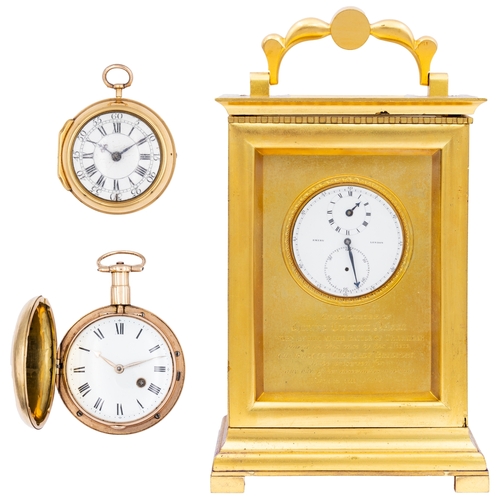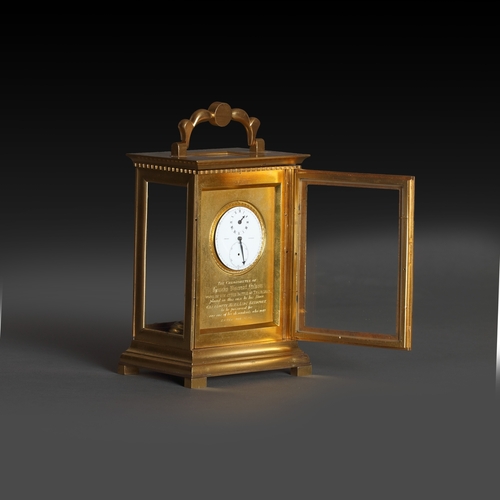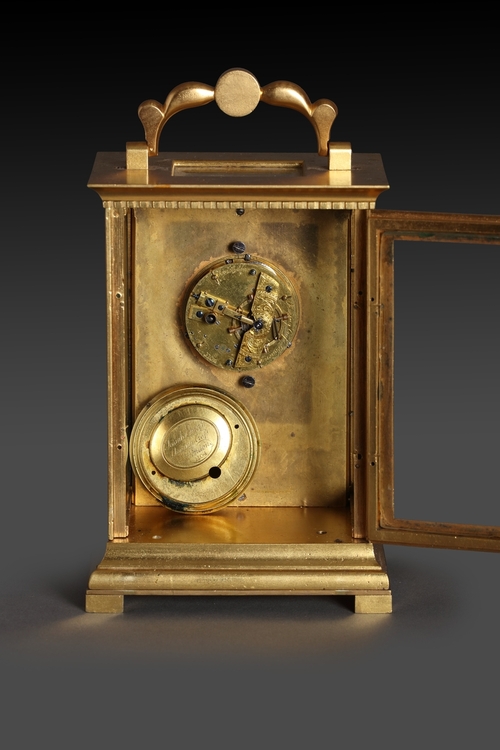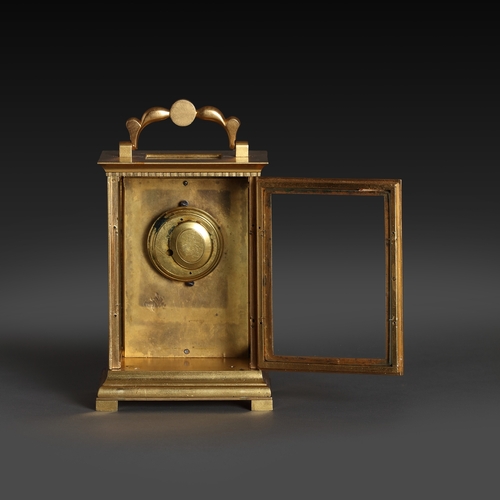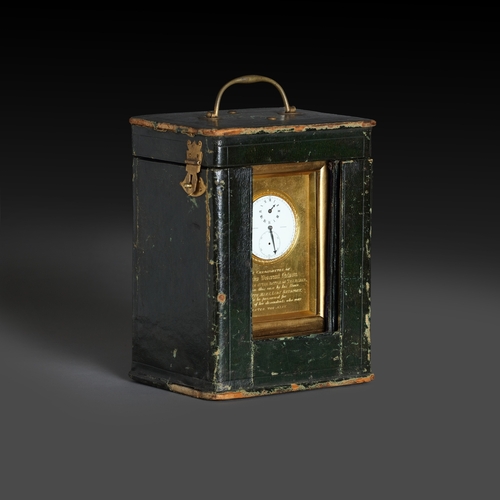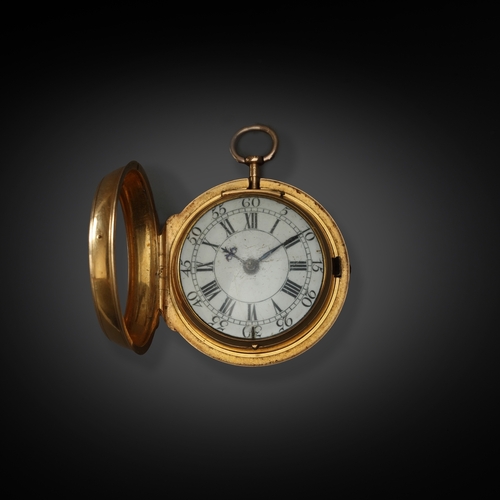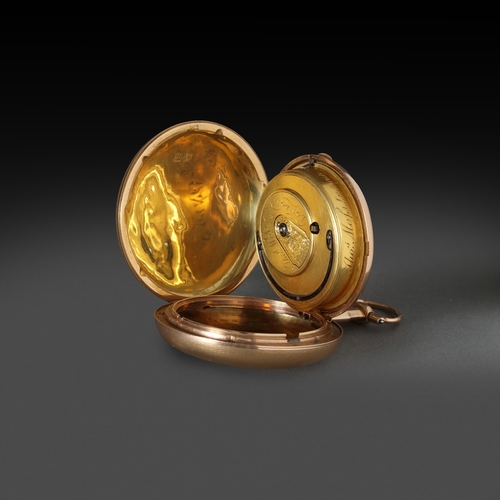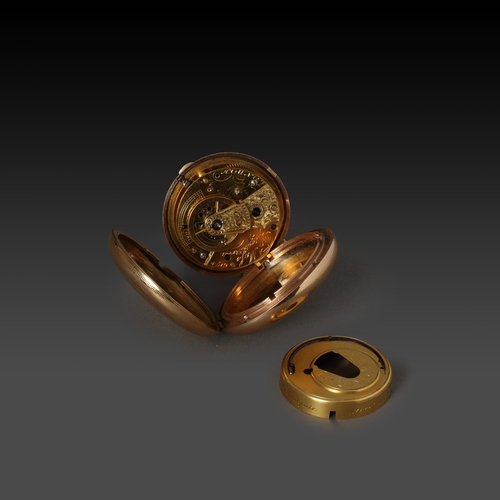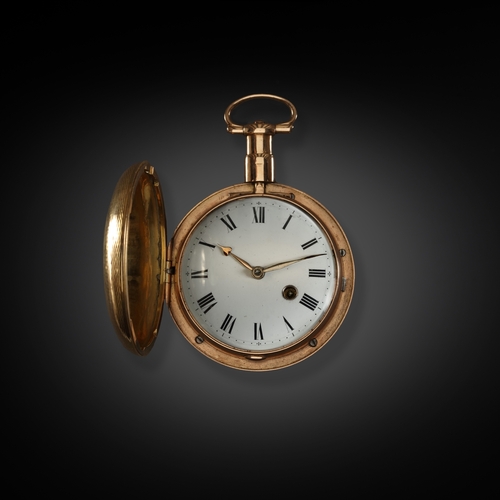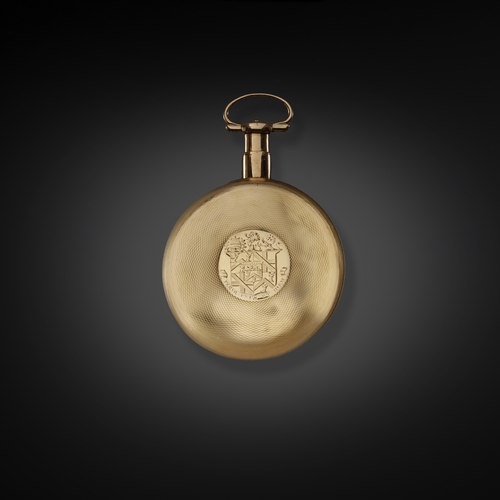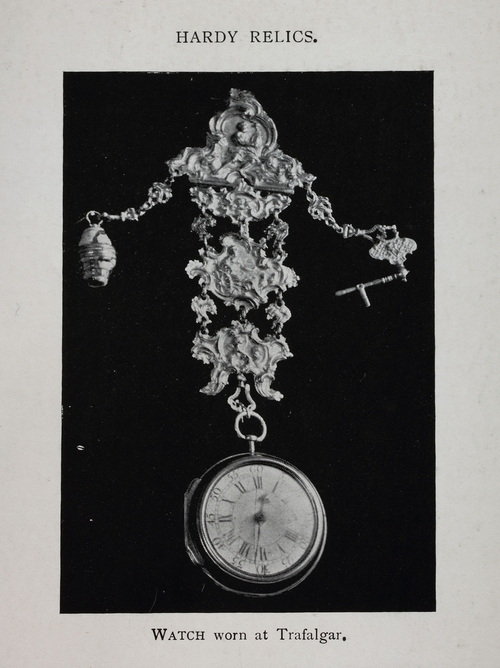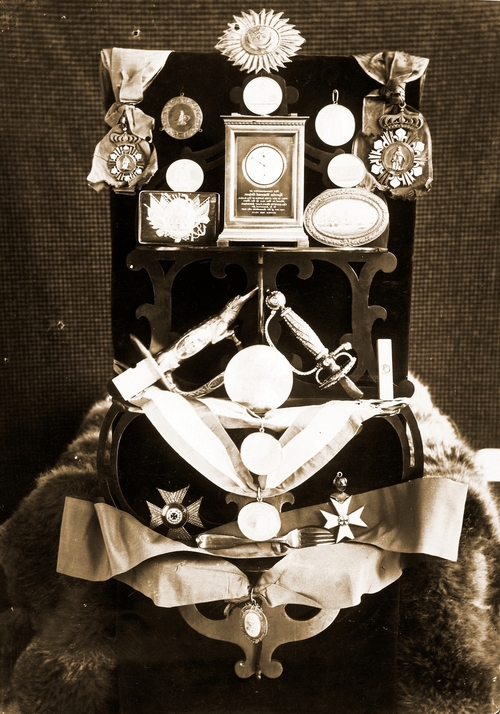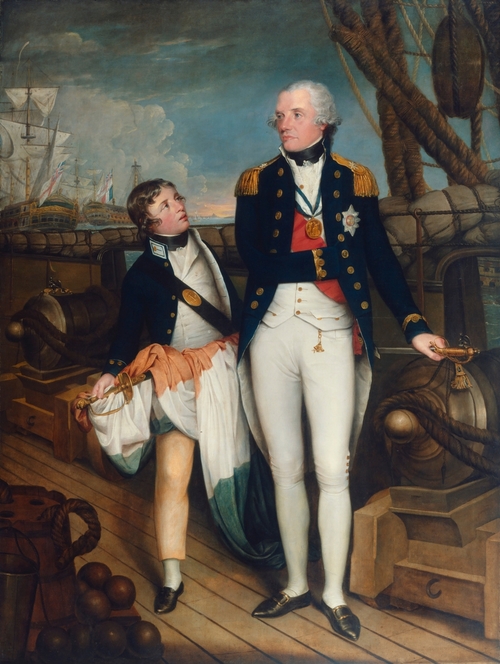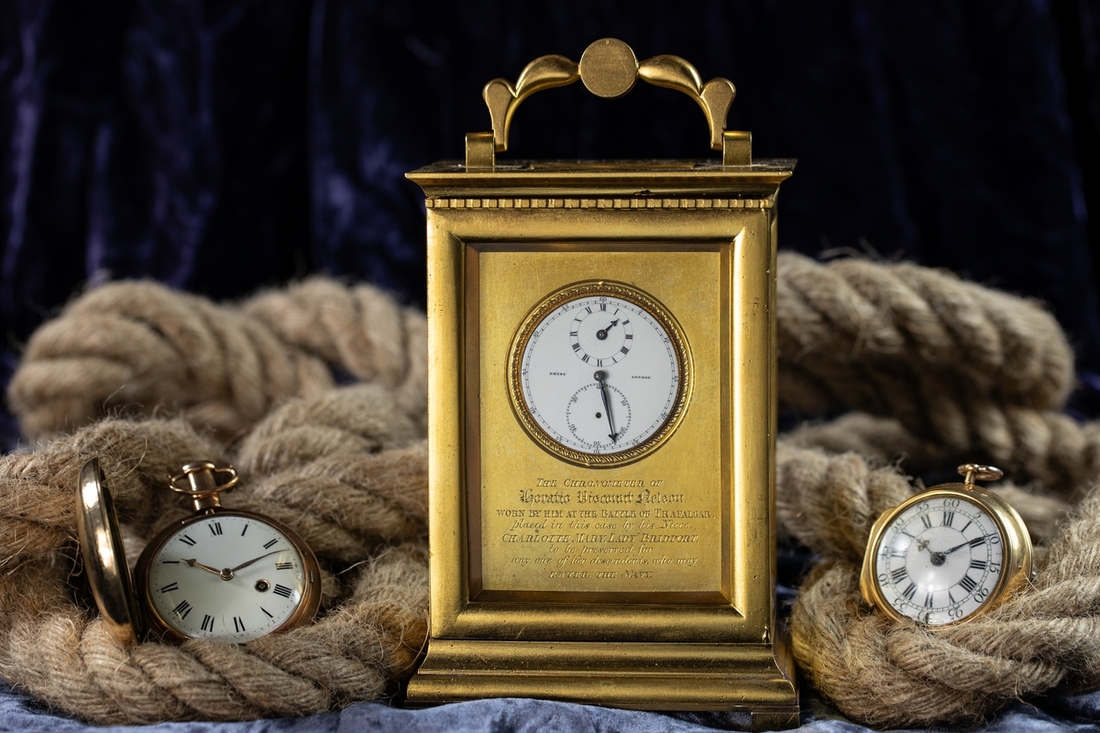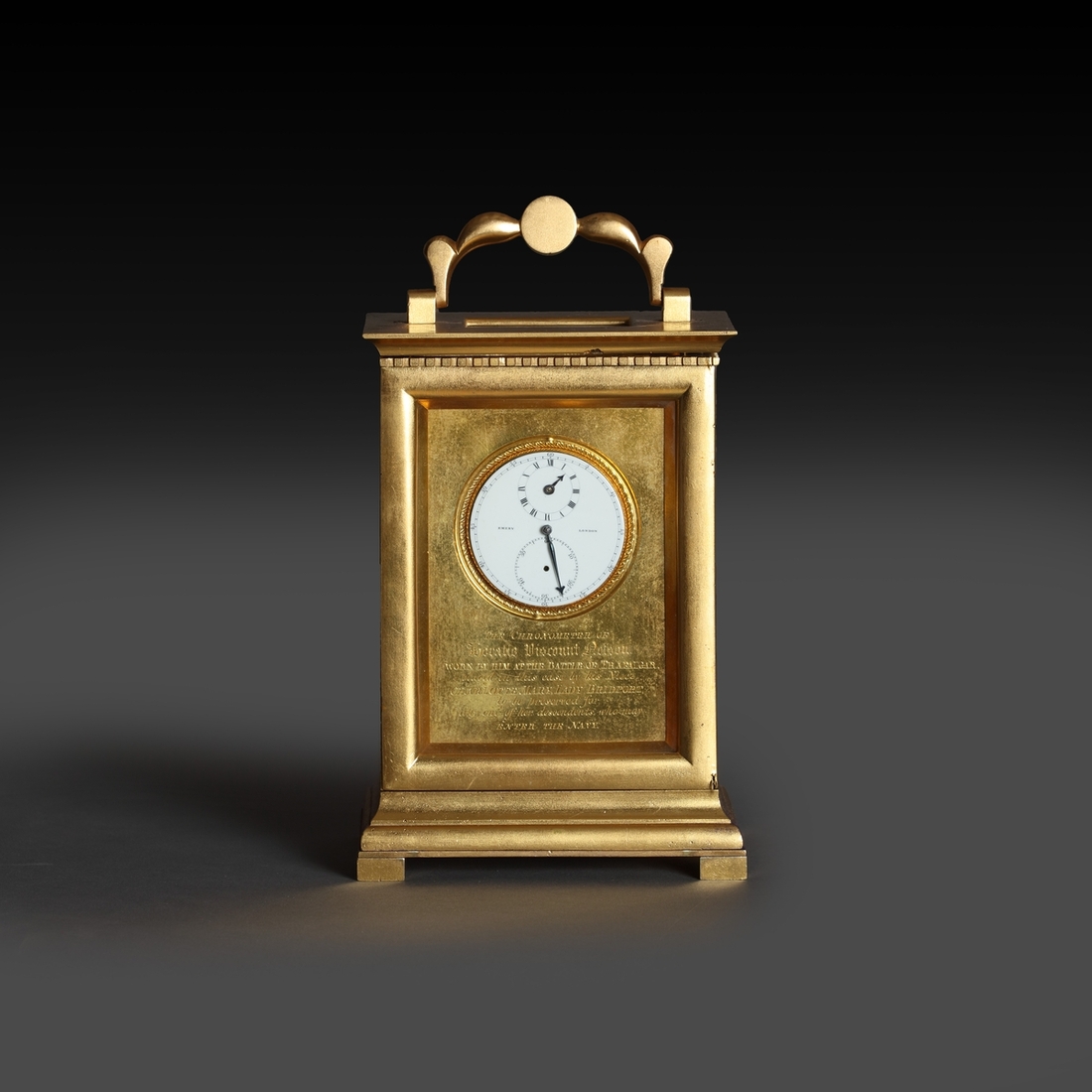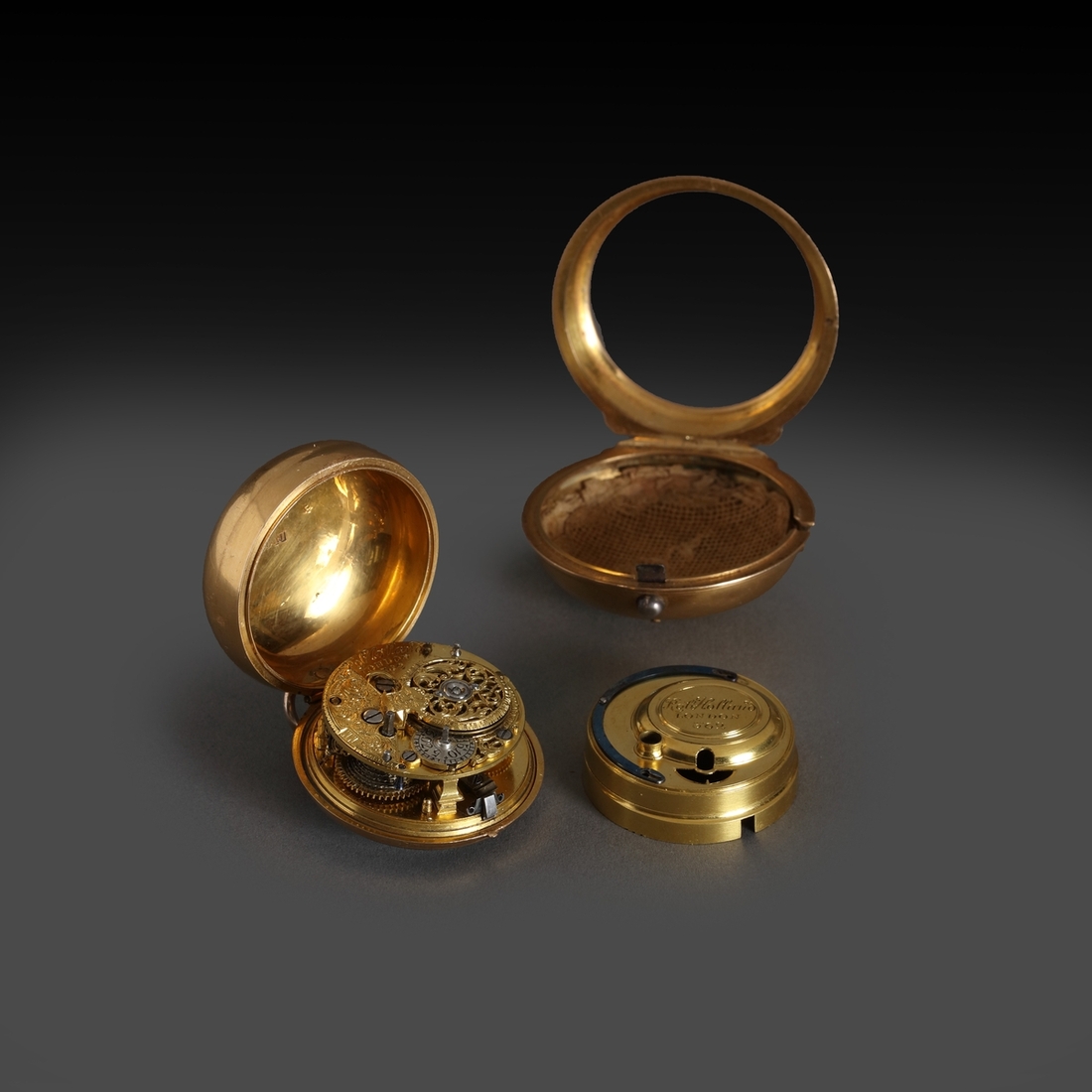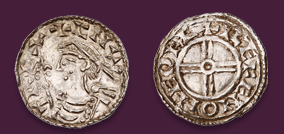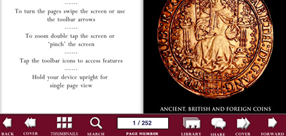Auction: 25360 - The 360th Anniversary Sale
Lot: 65
THE WATCHES WHICH WON THE BATTLE OF TRAFALGAR
Property of a Private Collector
The Three Pocket Watches carried by Vice Admiral Lord Viscount Nelson, Captain Thomas Masterman Hardy and Rear Admiral Cuthbert Collingwood at the Battle of Trafalgar.
Comprising:
ADMIRAL LORD NELSON'S TRAFALGAR POCKET WATCH
A fine and very rare pocket watch movement with early lever escapement, later mounted in a carriage clock case, signed Josiah Emery, Charing Cross, London and numbered 1104.
Diameter of watch dial 1 ¾ in./45 mm; height of clock case 6 ¼ in./15.5 cm.
English, London circa 1790, with gilt full plate movement, straight line two-plane lever escapement, jewelled pallets and impulse, gilt four-arm balance, double S balance wheel with two gold timing screws and two gold adjusting screws, steel escape wheel, jewelled holes, balance and lever with screwed down caps, engraved balance bridge with diamond endstone, fusee with Harrison's maintaining power, stop lever now lacking; gilt dust cap; white enamel regulator style dial, eccentric hour dial with Roman numerals, outer Arabic minute track, subsidiary dial for seconds; dial signed, cap and movement signed and numbered: Josiah Emery, Charing Cross London, 1104.
Later mounted in a gilt carriage clock form case with gilt mask and swing handle, engraved inscription:
THE CHRONOMETER OF
Horatio Viscount Nelson.
WORN BY HIM AT THE BATTLE OF TRAFALGAR,
placed in this case by his niece
CHARLOTTE MARY, LADY BRIDPORT,
to be preserved for any one of her descendents, who may
ENTER THE NAVY.
In a leather outer carrying case.
Accompanied by a portrait miniature of Charlotte Mary Hood (née Nelson), Lady Bridport, Duchess of Bronte (1787-1873), niece of Admiral Viscount Nelson, by Robert Thorburn (1818-1885), watercolour on ivory, English, circa 1840. 12.8mm high. Frame engraved: Charlotte Bridport, Duchess of Bronte B. Sept. 20 1787. D. Jan. 29 1873.
CAPTAIN HARDY'S TRAFALGAR GOLD POCKET WATCH
'The watch he wore while he held the dying Nelson in his arms'
A.M. BROADLEY & R.G. BARTELOT, 1909.
English, London 1755, with gilt full plate key wind cylinder escapement, plain three-arm balance, pierced and engraved balance cock, silver regulation, diamond end stone, white enamel dial, black Roman numeral hour markers, black outer minute track with Arabic numeral five-minute markers, blued steeled hands; yellow gold pair case, hallmarked London 1755, polished inner and outer. Signed Robert Holland, London, and numbered 362; with old paper exhibition label stating WATCH WORN BY CAPT HARDY OF TRAFALGAR.
Diameter approx: 2 in./49mm.
ADMIRAL COLLINGWOOD'S TRAFALGAR GOLD POCKET WATCH
English, London 1803, with pierced cock, flat brass three-arm balance with compensation, Duplex escapement, cylindrical pillars, enamel dial with Roman numerals, winding aperture at 4, gold spade hands, dust cap signed on the top and along the side, 18ct gold consular case with London Hallmark for 1803, and case makers mark DW for Daniel Walker of 49 Clerkenwell Close. The frosted gilt movement signed Thomas Moss, Ludgate Street, London and numbered 6174.
The case cover later engraved with the coat of arms, crests and motto of Admiral Lord Collingwood with Trafalgar augmentation.
Diameter approx: 2 in./53mm.
Anxiously consulted throughout the Battle of Trafalgar, two of these watches remained with their owners when a great victory was assured; the third was reverently removed from the blood stained and torn clothing of its owner as he lay dying in the Orlop of HMS Victory. All three watches were then preserved and treasured by their respective families until sold in 1938 (Hardy's), 1979 (Collingwood's) and 2005 (Nelson's). In 2024, by a remarkable historical convergence, the watches were reunited by a private collector for the first time since 21 October 1805 and it is to be hoped they remain so, to tell the story of one extraordinary day long ago.
In many ways, the watches represent the personalities of their owners. Inevitably, the most eye-catching watch of the three - and already widely celebrated and exhibited - is that belonging to Nelson. Rightly, it is also the rarest of the watches having been made by Swiss-born Josiah Emery (1725-1794) who, working in London, is today considered one the very best and most sought-after watchmakers of the late 18th century. Numbered 1104, Nelson's watch was one of just 38 examples (of which 22 are known to survive) made by Emery with his revolutionary lever escapement of an unsurpassed precision and complexity. Emery was also engaged in the search for establishing longitude at sea, and so it is unsurprising that Nelson should be drawn to his timepieces. However, it is unlikely he purchased the watch himself, lacking the wherewithal to do so before Emery's death in 1794. Most probably, Nelson was presented with the watch following his victory at the Battle of the Nile in 1798 when he was showered with awards, decorations and gifts. Possible donors include Nelson's wealthy agent Alexander Davison who, it is known, owned a gold repeater by Emery; or a grateful foreign prince as Emery supplied many courts in Europe. He also made timepieces for King George III and for the Prince of Wales who owned a very similar gold pocket watch by Emery, No. 1057.
Certainly, Nelson prized his watch taking it - as evidenced by markings on the movement - for overhauling at a watchmaker on his last leave in London in September 1805. This was likely to Louis Recordon of Cockspur Street who had succeeded to Emery's business and where Nelson is known to have purchased a watch at the time as a final gift to his lover Emma, Lady Hamilton.
Nelson wore his watch - with gold chain and seal - tucked into a pocket of his breeches, as shown in a full-length portrait of the admiral completed from life in Italy by Guy Head following the Battle of the Nile. No doubt he did the same on the morning of 21 October 1805 as the British and combined enemy fleets slowly converged in light winds ahead of the tumultuous action. At about ten that morning, as Victory's surgeon William Beatty later recounted, Nelson 'called Lieutenant Pasco, Mr Ogilvie, and some other officers, near him, and desired them to set their watches by the time of that which His Lordship wore'. Indeed, as Nelson once declared, 'Time is everything, five minutes makes the difference between victory and defeat.' Since he was a young midshipman, Nelson's life had run to the eight-hour watch system of the Royal Navy: time he further dissected and recorded in his journal writing and, to the last day of his life, the discipline of keeping a weather log. But Nelson's own time was running out. Three hours after setting his watch with his officers, at around 1pm, as the action reached its peak, Nelson was mortally wounded by musket fire, falling into the blood and guts that covered his quarterdeck. He was taken below to the cockpit where he died about three hours later, knowing of his triumph but anxious for the future of his lover and their child.
Captain Hardy, who had visited the cockpit on several occasions as the fateful afternoon wore on, understood his grave responsibility to his dead commander and friend. He secured Nelson's valuable personal belongings and arranged for them to be returned to Emma Hamilton following Victory's arrival in England. There, Nelson's overbearing brother and heir William, now ennobled as Earl Nelson, identified those objects which were to be treated as family heirlooms, such as medals, swords and the watch; and other relics, like the admiral's hair, which could be given to Emma. Nelson's 'gold watch' was seventh in a list of nineteen articles prepared by the executors. In due course, the heirlooms passed to the earl's daughter, and sole surviving child, Charlotte Nelson. She later arranged for the watch to be mounted for display in a carriage clock case to be preserved for 'any one of her descendants who may enter the navy'. In 1891, the watch was a highlight of the Royal Naval Exhibition in Chelsea, then, four years later, Charlotte's son Alexander Hood, Viscount Bridport, had the watch photographed, together with his other family heirlooms. Fortunately, he abided by his mother's injunction passing the watch in his lifetime for safekeeping to his son Commander Horatio Nelson Hood RN. This prevented a catastrophe as the other family heirlooms were purchased by the Nation for the Royal Hospital Greenwich where, in December 1900, they were stolen from The Painted Hall and never recovered. The theft left Nelson's watch as the most precious, intimate and historically significant of all his surviving belongings. From 1962 until sold in 2005 it was in the care of the National Maritime Museum, Greenwich.
On display beside Nelson's watch at Chelsea in 1891 - as its owner had once stood beside his commander on the quarterdeck of Victory - was the gold pocket watch worn at Trafalgar by Captain Thomas Masterman Hardy (1769-1839). Unlike the deluxe pocket watch afforded Nelson, Hardy's watch, like the man himself, was robust, reliable and reassuringly old fashioned, betraying his solidly provincial background. Made by Robert Holland in 1755, it was likely a family piece lovingly passed to Thomas when he entered the navy in 1781. No doubt it accompanied him - as Hardy did Nelson - to the battles of Cape St Vincent, Nile and Copenhagen before it marked time at Trafalgar. Later preserved by his family who exhibited then published it in 1906, the watch was eventually sold at auction in Dorset in 1938 whence it disappeared until its recent re-discovery. In Hardy's 1909 biography his watch was evocatively described as 'The watch he wore while he held the dying Nelson in his arms'. It is extraordinary to consider, gazing at them today, that both his own and Nelson's watch were in Hardy's possession as darkness fell over the shattered fleets.
However, it is the third watch which has perhaps the most poignant story. It is the gold pocket watch belonging to Admiral Cuthbert Collingwood (1748-1810), second-in-command at Trafalgar and first into action in Royal Sovereign at the head of the leeward division. Later that fateful day, he would assume command of the fleet following Nelson's death. This watch was made in London in 1803 by Thomas Moss and purchased by Collingwood during his last leave in England, two years before the battle. In May that same year he was recalled to sea (with his dog Bounce) and there he remained for the next seven years: never seeing his family again, losing Bounce when he was drowned, and dying at sea himself in 1810, having just relinquished his marathon command. Unusually - in a sign of the high regard in which Collingwood was held - his body was brought back to England and there laid in a tomb beside his old friend Nelson in the crypt of St Paul's Cathedral. His watch was returned to his family who engraved it with the coat of arms which Collingwood had earned when the king ennobled him in his absence after Trafalgar but which he never had the chance to display.
Three men, three watches, three stories: forever united in triumph and tragedy.
i) Admiral Lord Nelson's Trafalgar Pocket Watch
Provenance
UK Private Collection.
Sold Treasures, Sotheby's London, 4 July 2018.
Sold by Private Treaty, Sotheby's London, October 2005.
By family descent until bequeathed in 2004.
Isabella Emily Leveson (1845-1939)
Commander Hon. Horatio Nelson Sandys Hood RN (1843 -1881)
Alexander Nelson Hood, first Viscount Bridport (1814-1904)
Charlotte, Lady Bridport (1787-1873)
William, first Earl Nelson (1757-1835)
Vice-Admiral Horatio, Viscount Nelson K.B. (1758-1805)
Exhibited
2015: Admiral Farragut Academy, St. Petersburg, Florida
1962-2015: On loan at the National Maritime Museum, Greenwich.
1930: On loan at the Royal United Services Museum, Whitehall.
1891: Royal Naval Exhibition, Chelsea. Catalogue no. 3001.
Literature
Jonathan Betts, Josiah Emery: The Surviving Lever Watches, Antiquarian Horology, Number Two, Volume Twenty-Three (1996), pp. 134-150.
Colin White (ed.), The Nelson Companion (1997, first pub; 1995), p.71.
Rina Prentice, The Authentic Nelson (2005), pp.133-4.
ii) Captain Hardy's Trafalgar Gold Pocket Watch
Provenance
UK Private Collection.
Sale of William Manfield Estate, Henry Duke & Son, Portesham House, Dorset, 17th June 1938, Lot 130: 'Admiral Sir Thomas Hardy's watch'.
William Hardy Manfield (1859-1937) of Portesham House, Dorset.
William Manfield (1832-1892) of Portesham House, Dorset.
Catherine Hardy (1762-1854) of Portesham House, Dorset.
Admiral Sir Thomas Masterman Hardy (1769-1839), of Portesham House, Dorset.
Exhibited
1933: Historical Treasures from Six Counties, Wilton House, Salisbury.
1905: Dorchester and the Navy, Dorchester County Museum Trafalgar Centenary Exhibition.
1891: Royal Naval Exhibition, Chelsea, Catalogue no. 3000.
Literature
A.M. Broadley & R.G. Bartelot, Nelson's Hardy His Life Letters and Friends, London, 1909, p. xiv., ill. opp. p.142.
A.M. Broadley & R.G. Bartelot, The Three Dorset Captains at Trafalgar, London, 1906, p. 60.
'Dorchester and the Navy. An interesting and important local exhibition in connection with the coming Trafalgar Centenary', The King, 29 July 1905.
This watch belonged to Captain Thomas Masterman Hardy and was carried by him at the Battle of Trafalgar on 21 October 1805. Hardy was also present with his watch at the battles of Cape St Vincent, the Nile and Copenhagen. Following his death in 1831, the watch descended in the family of Hardy's brother-in-law John Callard Manfield, married to his sister Catherine Hardy, with whom Hardy had been especially close. The Manfields' son, also John, entered the Royal Navy on Hardy's patronage and, as a midshipman in Ambuscade, dined in Victory with his uncle and Lord Nelson before Trafalgar.
iii) Admiral Collingwood's Trafalgar Gold Pocket Watch
Provenance
UK Private Collection
Bonhams, London, Lot 43, Fine Watches and Wristwatches, 13 December 2007
UK Private Collection
By descent in the Howell family until sold in 1979
Sarah Newnham-Collingwood (1817-1872), wife of John Howell
His daughter Sarah Collingwood (1792-1851), wife of George Newnham
Vice-Admiral Cuthbert Lord Collingwood (1750-1810)
Subject to 20% VAT on Buyer’s Premium. For more information please view Terms and Conditions for Buyers.
Estimate
£800,000 to £1,200,000
Starting price
£750000

